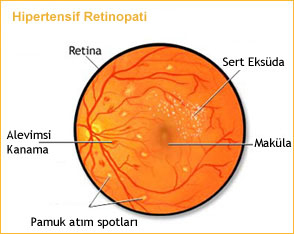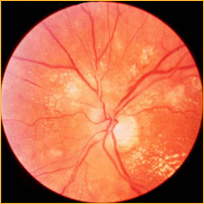Hypertensive Retinopathy

Hypertensive retinopathy is damage to the retina caused by high blood pressure.
High blood pressure causes damage to blood vessels in the eyes. The higher the blood pressure and the longer it has been high, the more severe the damage is likely to be. If hypertensive retinopathy is severe, it can affect vision.
If you have high blood pressure, you should let your ophthalmologist know that you have high blood pressure and what medicines you may be taking.
Hypertensive retinopathy can occur when high blood pressure has not been well controlled for a long time or the blood pressure suddenly increases. The retinal arteries respond to high blood pressure by narrowing. Over time, the vessels become stiff and they can push on nearby retinal veins. Damage to the blood vessels can cause them to change shape over time. They may also leak, leading to retinal bleeding and swelling of the retina. The patient can also have swelling of surrounding nerves called cotton wool spots.
If the blood pressure suddenly increases, severe leakage can occur from the retinal arteries, causing bleeding within the retina and swelling of the retina and optic disc. This is called malignant hypertension.
At the early stages of hypertensive retinopathy, no specific symptom is observed. Headaches and visual disturbances as blurred vision can occur later

Blood pressure measurement is the essential.
Ophthalmologic examination shows narrowing of blood vessels, and excess fluid oozing from blood vessels. The degree of retina damage (retinopathy) is graded on a scale of I to IV. At grade I, no symptoms may be present. Grade IV hypertensive retinopathy includes swelling of the optic nerve and of the visual center of the retina. Such swelling can cause decreased vision.
Control of high blood pressure is the only treatment for hypertensive retinopathy. Medical co-management with the primary physician is of paramount importance.
If a patient presents with papilledema from hypertension, then the patient has malignant hypertension and should be considered to be in medical crisis. This patient needs immediate transport to a hospital emergency room.
When high blood pressure is severe and life threatening, treatment may be needed immediately to save vision and avoid other complications, including stroke, heart failure, kidney failure, and heart attack
Last Updated: October 23, 2024



























